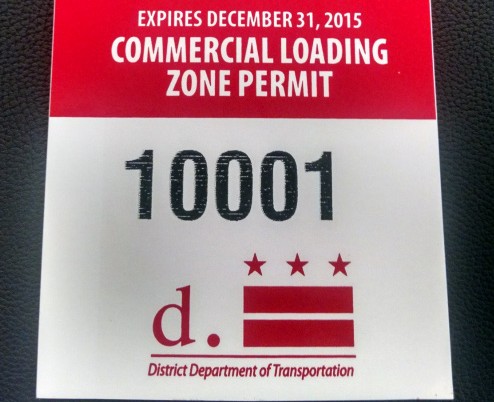Commercial Loading Zone Management Program: Washington, D.C.
Printable Version [PDF, 293 KB]
You may need the Adobe® Reader® to view the PDFs on this page.
Contact Information: Freight Feedback at FreightFeedback@dot.gov

U.S. Department of Transportation
Federal Highway Administration
Office of Operations
1200 New Jersey Avenue, SE
Washington, DC 20590
FHWA-HOP-17-022
March 2017
Overview
In January 2015, the District of Columbia’s Department of Transportation (DDOT) launched a multi-faceted program to improve management of the city’s more than 500 curbside loading zones. Improvement efforts included:
- Inventorying all commercial loading zones (including signage) within the city.
- Adjusting regulations to support program needs.
- Applying freight data to evaluate loading zone demand.
- Involving the freight community throughout the process.
Background
In 2007, D.C.’s Downtown Business Improvement District (BID) established a pilot parking program, which helped build momentum for developing the city’s Commercial Loading Zone Management Program (CLZMP). The pilot program first focused on K Street NW, one of the downtown’s busiest commercial thoroughfares. K Street NW is a four-lane, two-way street with a protected service roadway in both directions. The service roadway contains one lane for travel and one for parking (passenger) or loading/unloading (commercial). Commercial vehicles sometimes arrived at their destinations to find no open spaces, and then blocked the travel lane by double parking.
For the pilot program, multi-space parking meters were installed on blocks with commercial loading zones. To alleviate congestion caused primarily by these double-parked commercial vehicles, parking enforcement focused on K Street. Assisted by DDOT and the Golden Triangle BID, the Downtown BID collected pre-and post-pilot data on travel times, parking occupancy, curbside uses, parking turnover, and parking violations. Results showed travel times across all modes of travel improved measurably following the pilot’s implementation, and without a substantial disruption of commercial activity. This success eventually led to citywide implementing of the CLZMP in 2015.
KEY ACCOMPLISHMENTS
- Improved use of existing loading zones within the District.
- Fostered partnerships with stakeholders to achieve favorable outcomes.
- Developed loading zone permitting procedures and a payment system for use of commercial loading zone spaces.
- Established a curbside loading zone evaluation process.
Process
DDOT collected a significant amount of data during the 18 months leading up to implementing CLZMP. Assisted by internal staff and the Metropolitan Washington Council of Governments, DDOT inventoried all the loading zones in D.C., and documented all dimensions, signage, and time restrictions. Using the Arc GIS Collector application, DDOT collected data and created an interactive map, available at (www.godcgo. com/truckandbusmap).
DDOT also utilized occupancy rate data based on business type, truck type, number of deliveries, average length of stay, number of businesses per block, and number of observed conflicts. The agency improved its internal decision-making processes by using this data to develop a model that helps determine if a particular block should have a loading zone. DDOT is considering adding other data categories (e.g., business revenue) to further improve the model.
Communication and engagement were crucial to the successful implementation of the CLZMP. DDOT engaged in comprehensive stakeholder outreach to independent companies; local, regional, and national carriers; national and State trucking associations; and local BIDs. DDOT also distributed literature about the CLZMP through print and online media. Additionally, DDOT coordinated with the Department of Public Works (DPW) and the Metropolitan Police Department (MPD) to clarify regulations on design and placement of permit decals.
Rules & Procedures for D.C.’s Loading Zones
Access permit applications on DDOT’s Transportation Online Permitting System (TOPS) at: https://tops.ddot.dc.gov/.
Annual and day permits allow commercial vehicles to park in loading zones during designated time frames for up to 2 hours; annual permit holders can park in metered spaces between 10:00 am – 2:00 pm. The time periods help commercial users complete their routes more quickly and efficiently, decreasing congestion for others. Types of permits available include:
- Annual permits for 1 calendar year— a cost-effective option for large carriers. Each business registers with TOPS and applies for as many permits as they have vehicles that utilize loading zones. Each business must pay for the first 75 vehicles, after which each additional vehicle is free.
- Day permits for 24 hours— for carriers that do not frequent the D.C. area. However, very few carriers have used the day pass since the program launched. In the future, DDOT will consider whether it is in the best interest of the city and users to continue offering this option.
If a driver does not obtain a vehicle permit in advance, then he or she may pay for the space upon parking. Instructions posted on the loading zone signs direct drivers to use the Park mobile service to pay by calling or using the smartphone application.
Additional information at: www.godcgo.com/freight.
To address carrier complaints about passenger vehicles using loading zone spaces, DDOT increased the fine for unauthorized vehicles from $50 to $100. Additionally, DDOT, DPW, and MPD worked together to enforce the new regulations as the program rolled out; they continue to do so.
Lessons Learned and Recommendations
More than 12,000 metered transactions occurred during the first three months of the program; more than 70 businesses obtained annual permits in its first six months. To assess the program, DDOT plans to solicit feedback from stakeholders and gather data such as the number of double-parking citations issued and travel time on key corridors during certain time frames.
According to DDOT, jurisdictions interested in replicating this program should:
- Inventory existing loading zones and collect data on their use.
- Coordinate with city police about enforcing loading zone changes.
- Offer multiple methods of payment and investigate new forms of payment as they become available.
- Engage with carriers, downtown receivers, and local BIDs.

Example of an annual permit decal. (Source: DDOT)
Local Contacts:
Laura Richards
DDOT
laura.richards2@dc.gov | (202) 671-2226
Alex Block, AICP
Downtown BID
alex@downtowndc.org | (202) 661-7590